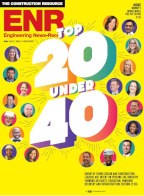With two offices in California and a third soon to follow, Arup has made its presence felt in the Golden State since 1987. But the firm's prominence rose to new heights in the past year through innovative designs, key roles on several high-profile projects and a deep commitment to a multidisciplinary approach in addressing clients' needs.
Founded in London in 1946 by Ove Arup, the firm has been held in trust since the 1970s on behalf of its employees, who, the company says, maintain its independent spirit. The California office's 2012 billings totaled $94.3, up 3% from 2011.
Arup often shares its workload among its many global offices, which protects it from regional economic conditions, says Andy Howard, chief operating officer for the Americas region. "We are great believers in trying to maintain those valuable people that we've got in the organization. Sharing work has helped us be very resilient during the recession," he says.
The firm's staff has been busy on such major projects as the $1-billion Gerald Desmond Bridge Replacement in Long Beach; aspects of the $4.2-billion Transbay Transit Center in San Francisco; and sustainable hospitals, including the $1.3-billion UCSF Medical Center at Mission Bay and Kaiser Permanente San Diego Central Medical Center.
Multidisciplinary Approach
Reflecting Arup's multidisciplinary approach, it recently was selected to perform the structural, MEP, civil and facade engineering package for the 1.1-million-sq-ft Samsung America HQ (Device Solutions) project in Silicon Valley. It also will provide specialized consulting services in acoustics, lighting, vertical transportation, fire and life safety, and risk assessment.
Howard says this broad approach "is fundamental to our founder's belief in what he called 'total architecture.' [Ove Arup] felt our communities and our clients would get better, more valuable solutions if you brought everybody involved in problem-solving together with a common goal. This allows us to solve more complex problems because there's a spirit of generosity where people are part of the same team, with the same corporate goals and culture."
Having engineers from multiple disciplines work together also can have a positive effect on a project's sustainability level, says Erin McConahey, principal in the firm's Los Angeles office.
"If you are sitting in independent contractual obligations, you are going to want to preserve your fee," she says. "The work it takes to look at alternate [sustainable] solutions to solve some other contractual body's problems is not of business benefit to you." But because Arup works under the same project management and fee structure, there is collegiality among the disciplines that helps produce a total optimized package, she says.
The company's profits are shared by all of its offices regardless of whether one region did better than the others, says McConahey. She adds that, as a result, "there is no economic benefit for anyone in the firm to not help each other out, both in terms of sharing knowledge and in terms of making the right solution for our clients."
In 2012, more than 84% of Arup's California revenue came from projects pursuing sustainability goals or certification, putting Arup at the top of the ENR California green design firms ranking. Arup also has 103 LEED-accredited professionals in California, more than any other purely engineering firm .
"Being an employee-owned organization, the employees drive all of the firm's aims," Howard says. "Our people want us to be a leader in sustainability—to lead by example, lead by trying to influence our clients, while recognizing that we are a business."










